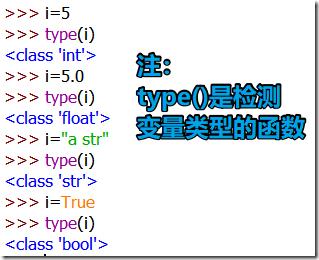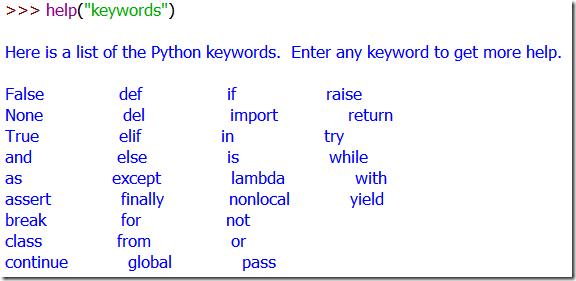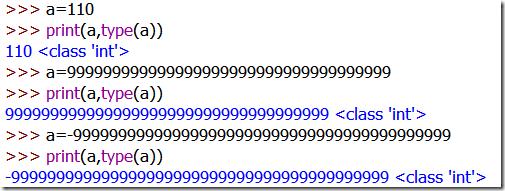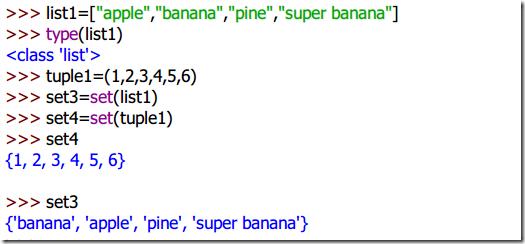本文实例讲述了Python变量、数据类型、数据类型转换相关函数用法。分享给大家供大家参考,具体如下:
python变量的使用不需要进行类型声明(类型名 变量名),给一个变量名赋什么值就是什么类型。
- 变量的赋值使用 =

说明:虽然python声明变量时没有一个类型来圈注,但它并不是弱类型语言,相反,它是一门强类型语言。
- 弱类型的语言的东西没有明显的类型,它能随着环境的不同自动变换类型;
- 而强类型则没这样的规定,不同类型间的操作有严格定义,只有相同类型的变量才能操作
为什么说 Python 是强类型语言
Python变量命名规则:
- 变量名只能是 字母、数字或下划线的任意组合
- 变量名的第一个字符不能是数字
- 不能与关键字重名(关键字用着用着就记熟了)

数据类型
整数int类型:
python3中移除了python2中的long
Python3中没有限制int数值的大小

- 可以用其他数制来表示数值:二进制是以0b开头的,8进制是以0O(第二个是英文o,大小写都可以)开头的,16进制是以0x开头的
>>> i=0b1111 >>> print(i) 15 >>> i=0x0010 >>> print(i) 16 >>> i=0o0010 >>> print(i) 8 >>> i=0O0010 >>> print(i) 8小数float类型:
- 可以用小数表示:3.1415,1.5,.......
- 也可以用科学计数法表示(10用e替代,比如0.000012可以写成
1.2e-5)
>>> a=1.5 >>> print(a) 1.5 >>> a=-9999.5 >>> print(a) -9999.5 >>> a=1.5e5 >>> print(a) 150000.0 >>> a=1.5e-10 >>> print(a) 1.5e-10 >>> a=0.0000000000000001 >>> print(a) 1e-16注:对于太小的数,会自动转化成科学计数法表示,太大的数不会自动转化
布尔bool类型:True、False
- 使用True和False两个关键字来表示布尔类型
- 可以使用非零数值表示True,但总觉得这是一个不好的习惯
>>> type(True) <class 'bool'> >>> type(False) <class 'bool'> >>> a=bool(2) >>> a True >>> a=int(True) >>> a 1 >>> print(int(False)) 0字符串str类型:
- Python不支持字符类型; 字符会被视为长度为
1的字符串 - 可以使用两个单引号,或两个双引号来代表字符串
>>> type("aaaa") <class 'str'> >>> type('aaaa') <class 'str'>- 可以使用下标来访问字符串的值【-1代表最后一位】:
>>> str1="123" >>> str1[0] '1' >>> str1[-1] '3'- 可以对字符串进行切片(切片方法:字符串名[左下标:右下标(不取到右下标)]),返回值是切片后的字符串,但并不会改变原字符串的值
【 [:]代表完全切片,[:右下标]代表从零开始,[左下边:]代表结尾是最后一位,-1下标代表最后一位 】
【切片也可以有间隔,用法字符串名[左下标:右下标:间隔] 】
>>> hello="hello world!" >>> new_hello=hello[:] >>> new_hello 'hello world!' >>> hello[:2] 'he' >>> hello[1:3] 'el' >>> hello[1:-1] 'ello world'>>> hello[1:-1:1] 'ello world' >>> hello[1:-1:2] 'el ol'- 可以使用三引号(单引号或双引号)来代表多行字符串
>>> type("""hahah haha hahah""") <class 'str'> >>> type('''第一行 第二行 第三行''') <class 'str'>列表list类型:
- list是一种有序的集合,可以随时添加和删除其中的元素。
- 使用中括号包裹元素,表明这是一个列表。[元素,元素,元素,.......]
>>> i=['a',100,True] >>> type(i) <class 'list'>- 列表的元素不限定数据类型,可以是字符串,可以是数值,可以是布尔类型,也可以是其他列表等等
- 列表可以是空的:list1=[]
- 可以使用list函数来创建列表
>>> list("abcd") ['a', 'b', 'c', 'd']- 列表也可以使用下标来访问元素,也可以切片,操作与字符串相同。
- 列表可以替换元素【使用 = 】:
>>> i ['a', 100, True] >>> i[0]='b' >>> i ['b', 100, True]- 如果列表中包含列表时,如果要取子列表中的元素,相当于操作“二维数组”,使用 列表名[索引][索引]:
>>> i ['b', 100, True] >>> l=[i,"helloworld"] >>> l [['b', 100, True], 'helloworld'] >>> l[0][0] 'b'- 可以使用“+”拼接列表,使用*重复列表
>>> l2=i*2 >>> l2 ['b', 100, True, 'b', 100, True] >>> l3=i+l >>> l3 ['b', 100, True, ['b', 100, True], 'helloworld']元组tuple类型:
- 使用()跟,来表示元组,当tuple中只有一个元素时,逗号可以特别的说明这是一个tuple,实际上,python也允许tuple定义时没有括号
>>> t1=('a',1,True) >>> type(t1) <class 'tuple'> >>> t2=('a') >>> type(t2) <class 'str'> >>> ####注意上面的类型### >>> t3=('a',) >>> type(t3) <class 'tuple'>>>> tuple2=1,2,3,4,5 >>> type(tuple2) <class 'tuple'> >>> tuple2 (1, 2, 3, 4, 5)- 有序列表叫元组,tuple的元素一旦初始化就不能修改,但可以存储list,因为tuple并不会复制一份list到自己的内存中,它只会存储list的内存指向,只要list的内存指向不变,就不跟tuple的不变原则冲突。
>>> t1=('a',i) >>> t1 ('a', ['b', 100, True]) >>> id(t1[1]) 1673650817160 >>> id(i) 1673650817160- tuple也可以可以使用下标来访问元素,也可以切片,操作与字符串相同。
- 元组可以为空
- 元组常用函数
tuple一旦初始化就不能修改,所以它没有append()、insert(),也没有pop()等能增删元素的方法
```python >>> tuple1=(1,2,3,4) >>> print(tuple1.index(2))#查找指定元素的下标 1 >>> print(tuple1.count(2))#查找某元素存在的数量 1```
字典dict类型:
- 使用键-值(key-value)存储
- 由于其哈希特性,因此具有极快的查找速度
- 可以使用{键1:值1,键2:值2,键3:值3 ...}来定义一个字典
>>> d1={'a':'apple','b':'banana','c':'cabbage'} >>> type(d1) <class 'dict'>- 字典是使用哈希算法来计算对应对应值的位置的,所以key必须是固定不可变的,在Python中,字符串、整数等都是不可变的,所以,可以作为key。其余元素可变的对象如list、set、dict就不能作为key,因为其元素结果不确定,无法确定哈希值。
>>> l1=['a'] >>> d1[l1]='c' Traceback (most recent call last): File "<pyshell#5>", line 1, in <module> d1[l1]='c' TypeError: unhashable type: 'list'- dict内部存放的顺序和key放入的顺序是没有关系的
- 可以使用 字典名[键] 快速查找出对应的值,键不存在则无法查找
>>> d1 {'a': 'apple', 'b': 'banana', 'c': 'cabbage', ('a',): 'c'} >>> d1['a'] 'apple' >>> d1['d'] Traceback (most recent call last): File "<pyshell#17>", line 1, in <module> d1['d'] KeyError: 'd'- 可以给某一个键的对应的值重新赋值,但由于一个key只能对应一个value,所以新的赋值会把就得值覆盖掉【如果定义的时候出现多个同名的键,这个键的值以最后的赋值为准】
>>> d1 {'a': 'apple', 'b': 'banana', 'c': 'cabbage', ('a',): 'c'} >>> d1['a']='apple pen' >>> d1 {'a': 'apple pen', 'b': 'banana', 'c': 'cabbage', ('a',): 'c'}- 可以使用 字典名[一个未使用的键]=值 来添加一个键值对:
>>> d1 {'a': 'apple pen', 'b': 'banana', 'c': 'cabbage', ('a',): 'c'} >>> d1['ai']='python' >>> d1 {'a': 'apple pen', 'b': 'banana', 'c': 'cabbage', ('a',): 'c', 'ai': 'python'}- 注:直接迭代字典,只能迭代出key
>>> dict10={1:"苹果","雪碧":"雪梨"} >>> >>> for i in dict10: print(i) 1 雪碧- 使用 字典名[key] 获取不存在的键时会抛出异常KeyError,可以使用成员运算符来避免或使用get()来避免
>>> dict10 {1: '苹果', '雪碧': '雪梨'} >>> 1 in dict10 True >>> 3 in dict10 False >>> print(dict10.get(3)) None >>> print(dict10.get(1)) 苹果集合类型:
- set和dict类似,也是使用大括号包裹
- 可以使用大括号来定义一个集合
>>> s1={'a','b','c'} >>> s1 {'b', 'c', 'a'} >>> type(s1) <class 'set'>- 可以使用set来定义一个集合,set函数的参数为一个可迭代对象(Iterable)
>>> s2=set() >>> type(s2) <class 'set'> >>> s3=set(['a','b','c']) >>> type(s3) <class 'set'>

- set不能使用下标来取出元素
- set的原理和dict一样,所以,同样不可以放入可变对象,因为它也是使用哈希来计算计算结果的,可以记作set与dict不同的是它只存储key,不存储value【set()函数传入一个字典作为参数时,只取key作为结果】
>>> s3.add(['cbd']) Traceback (most recent call last): File "<pyshell#37>", line 1, in <module> s3.add(['cbd']) TypeError: unhashable type: 'list'
数据类型转换相关函数:
int()函数可以把其他数据类型转换为整数:- float( )函数可以把其他数据类型转换成浮点数
- str( )函数可以把其他数据类型转换成字符串类型
- bool( )函数可以把其他数据类型转换成布尔类型
- tuple()将其他数据类型转换为元组。
- set()将其他数据类型转换为集合。
>>> print(type(int("123"))) <class 'int'> >>> print(type(float("123"))) <class 'float'> >>> float("123") 123.0 >>> str(123) '123' >>> bool(2) True >>> list("123") ['1', '2', '3'] >>> tuple("123") ('1', '2', '3')注:转换是有规则的,要符合规则才能转化,比如int()不能转换"abc"

希望本文所述对大家Python程序设计有所帮助。
-
<< 上一篇 下一篇 >>
Python变量、数据类型、数据类型转换相关函数用法实例详解
看: 1240次 时间:2020-11-18 分类 : python教程
- 相关文章
- 2021-12-20Python 实现图片色彩转换案例
- 2021-12-20python初学定义函数
- 2021-12-20图文详解Python如何导入自己编写的py文件
- 2021-12-20python二分法查找实例代码
- 2021-12-20Pyinstaller打包工具的使用以及避坑
- 2021-12-20Facebook开源一站式服务python时序利器Kats详解
- 2021-12-20pyCaret效率倍增开源低代码的python机器学习工具
- 2021-12-20python机器学习使数据更鲜活的可视化工具Pandas_Alive
- 2021-12-20python读写文件with open的介绍
- 2021-12-20Python生成任意波形并存为txt的实现
-
搜索
-
-
推荐资源
-
Powered By python教程网 鲁ICP备18013710号
python博客 - 小白学python最友好的网站!